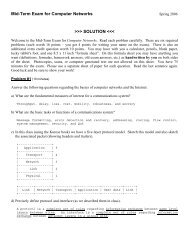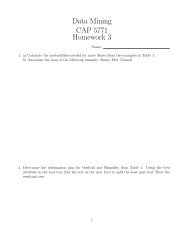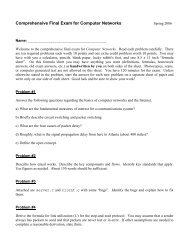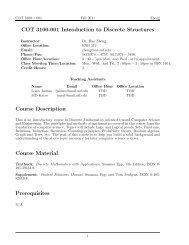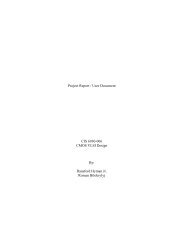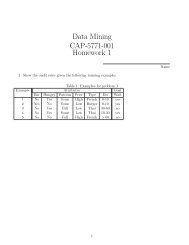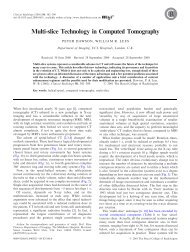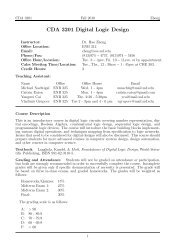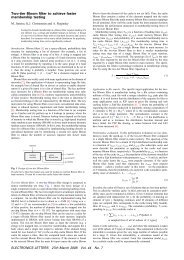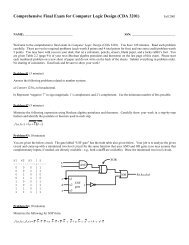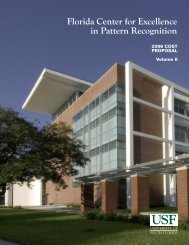The Generation of Fuzzy Rules from Decision Trees - Department of ...
The Generation of Fuzzy Rules from Decision Trees - Department of ...
The Generation of Fuzzy Rules from Decision Trees - Department of ...
You also want an ePaper? Increase the reach of your titles
YUMPU automatically turns print PDFs into web optimized ePapers that Google loves.
<strong>The</strong> <strong>Generation</strong> <strong>of</strong> <strong>Fuzzy</strong> <strong>Rules</strong> <strong>from</strong> <strong>Decision</strong> <strong>Trees</strong>Lawrence O. Hall and Petter Lande<strong>Department</strong> <strong>of</strong> Computer Science and EngineeringUniversity <strong>of</strong> South FloridaTampa, Fl. 33620hall@csee.usf.eduAbstractThis paper introduces two methods <strong>of</strong> developing fuzzy rules, using decision trees, <strong>from</strong> data withcontinuous valued inputs and outputs. A key problem is how to deal with continuous outputs. Hereoutput classes are created. A crisp decision tree may then be created using a set <strong>of</strong> fuzzy output classesallowing each training example to partially belong to the classes. Alternatively, a discrete set <strong>of</strong> fuzzyoutputs classes can be created which include a selected group <strong>of</strong> overlaps, such as classA.75/classB.25.<strong>The</strong> training examples can then be provided to a standard decision tree learning program, such as C4.5.In both cases fuzzy rules will be extracted <strong>from</strong> the resultant decision tree. Output classes will have to becreated for the case in which examples belong to discrete, but overlapping multiple classes. We discuss thetrade<strong>of</strong>fs <strong>of</strong> the two approaches to output class creation. An example <strong>of</strong> the systems performance using adiscrete set <strong>of</strong> overlapping classes on the the Box-Jenkins gas furnace prediction problem and a functionapproximation problem are given. <strong>The</strong> learned rules are able to provide effective control and functionapproximation.1. Introduction<strong>Decision</strong> tree theory [20, 19, 15, 14] provides a well-understood mechanism for inducing classificationrules <strong>from</strong> data. <strong>The</strong> attributes may be continuous or nominal valued, but the examples belong to discreteclasses. This paper explores the use <strong>of</strong> decision trees to generate fuzzy rules that might be used in acontrol setting. In this case both the input attributes and the output decision are continuous [10, 11, 3].Given a data set that describes a system state and an associated set <strong>of</strong> effective control actions, oursystem can be used to generate a set <strong>of</strong> fuzzy rules. <strong>The</strong>se fuzzy rules will form the basis <strong>of</strong> a fuzzycontroller. <strong>The</strong> rules may be further tuned or used directly.In building a decision tree for continuous input and continuous output data there are several decisionsthat must be made. <strong>The</strong> first is the criteria upon which the examples will be split into subgroups at eachnode in the tree. <strong>The</strong>re are different approaches and we use the information theoretic approach adoptedby Quinlan [19]. <strong>The</strong> second issue is how to deal with continuous outputs. One possibility is to clusterthem into a set <strong>of</strong> overlapping classes and use a decision tree in the usual way (i.e. assign examples toclasses), which is the approach taken here.Our initial system, called FCG (for fuzzy controller generator) [13, 8] can generate multiple input/singleoutput process controllers <strong>from</strong> a continuous-valued data set. It extracts fuzzy rules <strong>from</strong> a decision tree
created by the well known C4.5 learning system [20, 2]. FCG generates fuzzy CLIPS rules [17]. <strong>The</strong>generated rules can then be used as a fuzzy controller or a fuzzy function model and applied to real data.<strong>The</strong>re are several difficulties with FCG. One <strong>of</strong> our goals for the generation <strong>of</strong> fuzzy rules is to havea relatively small and understandable set <strong>of</strong> rules. FCG can, when applied to some domains, generatemore rules than are easy to understand. Also, it would be ideal to use the decision tree generated ruleswithout any tuning and the smoothness <strong>of</strong> the control or a fuzzy model provided by the initial rules canbe improved for some domains.In this paper a discussion <strong>of</strong> the problems and some potential remedies [9] is given. A small artificialexample will be used to illustrate an improved approach. In Section 2, we describe creating decisiontrees when all data, including the outputs, is continuous. In Section 3, FCG is described and Section4 discusses the areas in which the system might be improved and suggests improvements. Results <strong>from</strong>a commonly used data set, the Box-Jenkins gas furnace [5], and a function approximation problem areused for illustration. Section 5 is a summary <strong>of</strong> the work.2. <strong>Decision</strong> treesConsider the problem <strong>of</strong> determining whether to play tennis based on the weather: (Sunny, Cloudy),Wind: (Windy, Quiet) and Temperature (0,100 o F). <strong>The</strong>re are two outcomes (play, Don’t Play). Since weare only interested in continuous inputs, assume the level <strong>of</strong> windiness and cloudiness are <strong>from</strong> 0 (no windor clouds) to 10 (windy or cloudy). Given the training examples shown in Table 1 to C4.5, the decisiontree in Figure 1 would be produced. <strong>The</strong> decision tree allows the classification <strong>of</strong> examples into n classes(n=2 here) by choosing an attribute whose values may split the examples up into more homogeneousgroups. For continuous valued attributes a value in the data set is chosen as the “split point”. When acontinuous valued attribute is chosen as the attribute to partition a set <strong>of</strong> examples at a given node inthe tree, the examples will be split into 2 subsets, i.e. a binary split is done.Table 1. A training set <strong>from</strong> the domain <strong>of</strong> tennis.Weather Wind Temperature Class0 0 95 no play0 0 80 play10 10 75 no play10 4 65 play10 10 100 no play10 10 80 play<strong>The</strong> attribute values <strong>of</strong> a continuous valued attribute are each examined as a possible attribute forsplitting the example set at a node in a decision tree into subsets. <strong>The</strong> selection <strong>of</strong> a specific value isbased upon the information gain ratio associated with choosing that attribute [20]. <strong>The</strong> attribute, whichhas the highest information gain associated with it is chosen as the attribute for splitting the examplesat a node. <strong>The</strong> attribute’s information gain will be that <strong>of</strong> its value in the set <strong>of</strong> examples at the nodefor which the information gain is highest.In our example tree at the top level the attribute weather has only 1 possibility for a split and theinformation gain is 0. <strong>The</strong> temperature attribute has 4 possible choices (65, 75, 80 and 95; note everyexample is
Wind 75PlayFigure 1. A simple decision tree created by C4.5 <strong>from</strong> the examples in Table 1.2.1. Creating class labels<strong>The</strong> examples <strong>from</strong> which fuzzy rules will be created have continuous valued outputs. <strong>The</strong> C4.5decision tree algorithm requires crisp class assignments for all objects. It is necessary to partition thecontinuous output values into an effective set <strong>of</strong> discrete output classes. We use a modification <strong>of</strong> theapproach given in [21] to create output fuzzy sets. <strong>Fuzzy</strong> c-means (FCM) clustering [6] (with m=2) isdone on just the set <strong>of</strong> output values with variable numbers <strong>of</strong> clusters, denoted c in this paper. <strong>The</strong>partition validity metric [1]n∑ c∑S(c) = (u ik ) 2 (‖x k − v i ‖ 2 − ‖v i − x‖ 2 ) (1)k=1 i=1is used to determine the number <strong>of</strong> clusters c to use. <strong>The</strong> number <strong>of</strong> clusters, c, will correspond directlyto the number <strong>of</strong> classes in the FCG. In (1), u ik denotes the membership <strong>of</strong> the k th feature vector in thei th class or cluster, x k is the k th feature vector, v i is the i th cluster center and x is the average vectorcreated <strong>from</strong> the full set <strong>of</strong> feature vectors. <strong>The</strong> u ik ’s and v i ’s are obtained <strong>from</strong> first applying FCM(searching for c clusters) to the x k ’s.Clustering begins with c 0 = I with c 1 = c 0 + 1, c 2 = c 1 + 1, . . . and ends when S(c n ) > S(c n−1 ) withc n−1 ≥ c 0 . <strong>The</strong> usual case is I = 2, but to force finer grained partitions it is possible to set I > 2 andthis was done in some experiments.From our set <strong>of</strong> one dimensional feature vectors, c n fuzzy clusters are created within FCM. <strong>The</strong>yconsist <strong>of</strong> cluster centers v i , 1 ≤ i ≤ c n and membership values for each x k in the clusters representedby the v i ’s, which are contained in u ik . It is possible to create c n triangular fuzzy sets with each setcentered at one <strong>of</strong> the cluster centers v i . <strong>The</strong> spread <strong>of</strong> each symmetric fuzzy set is equal to twice thesmallest distance between any 2 cluster centers. Figure 2, shows the results <strong>of</strong> clustering 5 values into 2classes by showing the cluster centers and the associated triangular fuzzy sets. <strong>The</strong> largest 2 clusteredvalues (64, and 70) belong to centroid v2 with the smallest 3 belonging to v1.Since the clustering is one dimensional, we limit, each feature vector to membership in at most 2 classesor clusters. C4.5 requires that each training example presented to it belong to only 1 class. <strong>The</strong>refore, ourinitial approach is to create 5 possible classes to which a feature vector with some membership in class Aand class B may belong. If the membership <strong>of</strong> a feature vector is greater than 0.875 in A, it is assignedto class A. It belongs to class-A-B-25-75 if its membership in A is in [.125, .375), to class-A-B-50-50 ifits membership in A is in [.375, .625), and to class-A-B-75-25 if its membership in A is in [.625, .875). Ineach <strong>of</strong> our example instances the remaining membership would be in class B. <strong>The</strong>se joint classes can bedirectly implemented in terms <strong>of</strong> their component fuzzy sets representing class A and class B by usingfuzzy truth values in fuzzy CLIPS [17]. Joint classes will be further discussed in the next section.3
1.0Values to beclustered57256470Cluster centerswith c=2, rounded tonearest integer.v1 = 12v2 =6712 39.5 67 94.5122Figure 2. A simple example <strong>of</strong> creating triangular fuzzy output sets.To provide effective control at the extreme points in a domain, two boundary output sets are created[13, 8]. <strong>The</strong>se sets allow defuzzification to occur to a value larger/smaller than the largest/smallestcluster center during rule firing. <strong>The</strong> boundary sets are centered at the known extremes <strong>of</strong> each attribute(the largest and smallest value the attribute can take on). A training set example, x i , that is closer to aboundary set center than a cluster center created by the FCM clustering is assigned (µ boundary (x i ) = 1)the output class <strong>of</strong> the boundary set.2.1.1 An alternative approach<strong>The</strong> same clusters created by the output <strong>of</strong> FCM can be used to create a group <strong>of</strong> output fuzzy sets.<strong>The</strong>se sets can be approximated by trapezoidal fuzzy sets [21]. If the sets are created so that each outputvalue belongs to at most 2 <strong>of</strong> them, each training example will belong to 1 or 2 output classes (the fuzzysets). Since each training example may partially belong to one or more classes, the method <strong>of</strong> choosingan attribute value to split the examples at each node must be modified to account for the fuzzy nature<strong>of</strong> the training examples. In the next section, a discussion <strong>of</strong> how to incorporate fuzzy examples is given.3 Creating fuzzy rules3.1 FCGAfter a discrete class has been created for each example, as discussed in Section 2.1, C4.5 or anotherdecision tree creation program may be used to create a decision tree. <strong>The</strong> C4.5 program can createcompact rules <strong>from</strong> its decision tree after pruning the tree, but we found them too compact for ourpurposes. Our system operates on the un-pruned tree obtained <strong>from</strong> C4.5.<strong>The</strong> process <strong>of</strong> creating rules is quite simple. A complete depth first search is performed on the decisiontree and every time a path reaches a leaf, a rule is created with the antecedent being the and <strong>of</strong> each <strong>of</strong>the set <strong>of</strong> tests required to reach the leaf. <strong>The</strong> class <strong>of</strong> the rule is the class <strong>of</strong> the leaf. For example therewould be four rules created <strong>from</strong> the decision tree shown in Figure 1. <strong>The</strong> first (assuming the leftmostchild is expanded first in the depth first search) is:R1: IF temperature
experimentation showed that creating the antecedent fuzzy sets in this way gave control rules that werenot sensitive to small changes. <strong>The</strong>re was not enough fuzziness.Our experiments showed that significantly smoother rule outputs could be achieved across domains ifthe trapezoids were modified in two ways. <strong>The</strong> point at which the closed end <strong>of</strong> the trapezoid becomesnormal (height = 1) was modified <strong>from</strong> the baseline <strong>of</strong> the split value to be after an additional 28.5%<strong>of</strong> the ordered attribute values were covered. Ordered means that the attribute values were sorted <strong>from</strong>low to high. <strong>The</strong> point at which the closed end <strong>of</strong> the trapezoid reaches 0 was modified <strong>from</strong> the baseline<strong>of</strong> the first attribute value greater than the split point so that an additional 7% <strong>of</strong> the attribute values(or training cases) would be covered. In our example tree, 7% <strong>of</strong> 6 examples is .42, less than a fullexample. <strong>The</strong> fractional part can be used to adjust the zero point (or normal point) .42, in this case,<strong>of</strong> the distance to the next attribute value in the training set. <strong>The</strong>se overlap percentages were chosenempirically. Applying these adjustments to the temperature attribute in our rule, R1, results in thetrapezoidal fuzzy set shown in Figure 3b. Figure 3b also shows the fuzzy set for the > 80 side <strong>of</strong> the roottemperature split <strong>from</strong> Figure 1. <strong>The</strong> fuzzy set for > 80 is the mirror image <strong>of</strong> the fuzzy set for ≤ 80and created analogously.1.01.0 8040 80 95 Temperaturea40 68 80bTemperature97.5Figure 3. An example <strong>of</strong> antecedent fuzzy sets created <strong>from</strong> our simple tennis decision tree.<strong>The</strong> same continuous attribute can occur at multiple nodes in one path to a leaf, as temperature doesin Figure 1. In the case <strong>of</strong> the path to the leftmost no play leaf, temperature ≤ 80 and temperature≤ 75 occur. Since temperature ≤ 75 is the more restrictive <strong>of</strong> the two conditions, it will be kept in thegenerated rule antecedent. This results in the rule:IF temperature ≤ 75 and wind > 4 then No PlayIn general where the relational test for an attribute is ≤, the most restrictive condition will be kept.<strong>The</strong> final type <strong>of</strong> antecedent fuzzy sets that may be created are those that result <strong>from</strong> paths such as theone with thick lines in Figure 1. Along the highlighted path, the temperature attribute appears twice.To reach the leaf, temperature ∈ (75, 80] must hold. We call the fuzzy sets created <strong>from</strong> opposite splits<strong>of</strong> the same attribute along a given path to a leaf “between” sets. Figure 4 shows the between fuzzy set(the dashed triangle) created for temperature ∈ (75, 80]. It is created by first creating the trapezoidalfuzzy sets for the component split values as shown in Figure 4. <strong>The</strong>n the triangular “between” fuzzyset is created with a normal value at the midpoint between the zero points <strong>of</strong> its component sets or5
71+97.52= 84.25. <strong>The</strong> set goes to zero at the zero points <strong>of</strong> the sets created <strong>from</strong> the components makingup the between set or at 71 and 97.5 respectively for this example.1.0 7540Temperature71 80 97.584.25Figure 4. An example <strong>of</strong> the creation <strong>of</strong> a between set shown here by the dashed triangular fuzzy set.How to create rules, antecedent fuzzy sets and consequent fuzzy sets has been discussed. <strong>The</strong> finalpiece <strong>of</strong> the system involves generating rules for mixed classes like class-A-B-50-50 as discussed in Section2.1. For mixed classes two rules are created. For example, assume the following rule is created by parsinga decision tree:IF x < 50 <strong>The</strong>n class-A-B-50-50. <strong>The</strong> rule will be replaced by two the following two rules:IF x < 50 <strong>The</strong>n class-A (0.5) and IF x < 50 <strong>The</strong>n class-B (0.5), where the (0.5) values serve as certaintyfactors (in fuzzy CLIPS [17]) or can be viewed as rule firing strengths.<strong>The</strong> FCG system is written in C and produces rules in a format suitable for fuzzy CLIPS. In the nextsection, results obtained by running test cases through sets <strong>of</strong> learned fuzzy CLIPS rules are discussed.4 Problems with FCGWe first present some results and then analyze how the results might be improved. <strong>The</strong> first problemto which FCG is applied is to approximate the non-linear function f(x) = x 2 + x + 168. FCG is provided4 attributes: x 2 , x, and two random numbers one large (on the order <strong>of</strong> 10 4 ) and one small (on the order<strong>of</strong> 10). <strong>The</strong> random numbers were included to illustrate that a decision tree will provide effective featureor attribute selection. <strong>The</strong> training data ranged <strong>from</strong> f(−50) to f(50) at increments <strong>of</strong> 1. Leave one outcross validation training was done and 101 trees/rule sets were generated.<strong>The</strong> number <strong>of</strong> output classes ranged <strong>from</strong> 5-9 after clustering with FCM with 5 the most typical value.Only the two meaningful inputs were ever chosen as attributes, as expected, with only x 2 chosen for sometrees. <strong>The</strong>re were between 38 and 68 antecedent fuzzy sets created per rule set, resulting in between 17and 28 rules. <strong>The</strong> number <strong>of</strong> rules was typically 18 or 22. Testing was done on unseen values <strong>from</strong> 50 to111 in increments <strong>of</strong> 0.5. <strong>The</strong> results are given in terms <strong>of</strong> the MAPE, mean average percentage error:∑ ni=1[abs(y i − y i ′ MAP E =)/y i] × 100, (2)nwhere y i is the target output, y i ′ is the controller output and n is the number <strong>of</strong> test cases. <strong>The</strong> mosttypical (median) MAPE was MAP E = 2.71%. In general the approximation is acceptable, but thenumber <strong>of</strong> rules required is clearly high.In order to compare FCG to other fuzzy rule learning systems, it was also applied to the problem <strong>of</strong>predicting the CO 2 emission rate <strong>of</strong> a gas furnace, which burns a mixture <strong>of</strong> methane gas and air. This6
is <strong>of</strong>ten called the Box-Jenkins [5] gas furnace problem. Only the methane gas flow can be adjusted, callit x(t) at some time t. <strong>The</strong> system output is the current CO 2 emission rate, call it y(t) at some time t.We used 11 inputs the last 7 values <strong>of</strong> methane gas flow x(t-6), through x(t) and the last 4 values <strong>of</strong>the CO 2 emission rate or y(t-4) through y(t-1). <strong>The</strong> output <strong>of</strong> this predictive controller is y(t). <strong>The</strong> dataset consists <strong>of</strong> 290 examples. We did 29-way cross validation. <strong>The</strong> decision trees had between 6 and 13output fuzzy sets, 9-11 input variables, 139-200 fuzzy sets describing the input variables, and 66-86 ruleswere created. A typical rule set had 7 output fuzzy sets, 10 input variables defined by 175 fuzzy sets andconsisted <strong>of</strong> 76 rules. <strong>The</strong> average performance <strong>of</strong> the learned controllers was a MAP E = 0.958%. <strong>The</strong>average mean squared error (MSE) was 0.458. From [21] some comparisons can be made to other fuzzycontrol models created for this problem.<strong>The</strong> lowest MSE <strong>from</strong> hand tuned fuzzy rules resulted in an MSE=0.068 for a Takagi-Sugeno modelsystem. A learned (and tuned) model <strong>from</strong> [21] provided a MSE=.190. <strong>The</strong> average MSE <strong>of</strong> 4 handtuned systems was MSE=.293. Also, only one other system used as many rules and none used as manyinputs (the Takagi-Sugeno model used six inputs and others 2 or 3). Clearly, our system could havebenefited <strong>from</strong> some tuning.<strong>The</strong> reduction <strong>of</strong> the number <strong>of</strong> rules is one goal. Between 60-80 rules is hard to understand. Only 1(<strong>of</strong> 6) other systems created 81 rules for a MSE <strong>of</strong> .320. <strong>The</strong> next largest number <strong>of</strong> rules was 25, so it isclearly possible to create less rules. <strong>The</strong> other goal is to increase the system’s performance. <strong>The</strong> majorfactors that affect the system’s performance.1. <strong>The</strong> rules are encoded in the fuzzy CLIPS paradigm and a different paradigm such as the Takagi-Sugeno-Kang implementation found in MATLAB might be more flexible and effective [21, 11].Also, different defuzzification approaches might be used [7].2. <strong>The</strong>re are too many rules which make the resultant controller hard to understand. Recent work indecision tree learning has focussed on ways to create smaller trees when the attributes are primarilycontinuous [19, 15]. <strong>The</strong>se approaches may help create less rules.3. <strong>The</strong> granularity <strong>of</strong> the choice <strong>of</strong> output sets may not fine enough. However, the number <strong>of</strong> outputsets that get created with our current granularity is too large, which contributes to the large size<strong>of</strong> the decision tree. For example, consider just 5 classes after clustering which will result in 17output classes (meaning at least 17 rules are likely).In the following, we focus on how the number <strong>of</strong> fuzzy rules produced <strong>from</strong> a learned decision tree canbe reduced. <strong>The</strong>re are two ways that present themselves. <strong>The</strong> first is to use less output classes (just c forthe final c clusters) and allow examples to belong to multiple classes. <strong>The</strong> second (which can be easilycombined with the first) is to use one <strong>of</strong> the improved continuous value splitting approaches to minimizethe number <strong>of</strong> tests/splits in a decision tree. <strong>The</strong> improvements proposed in [19] for selecting splits forcontinuous attributes reduced the size <strong>of</strong> the tree produced by C4.5 when given the Box-Jenkins data set<strong>from</strong> 165 nodes to 163 nodes (after pruning), a negligible reduction.<strong>The</strong> fuzzification <strong>of</strong> the typical information theoretic measures used to determine how much informationis contained in the examples at a given node in a decision tree is straightforward. If there are N examplesat a node and C classes thenC∑Info(N) = − p(N, j) × log 2 (p(N, j)) (3)j=1where p(N,j) is the proportion <strong>of</strong> examples in N that belong to class j. <strong>The</strong> usual case is that for N=5,and 3 examples in Class 1, p(N, 1) = 3/5. <strong>The</strong> fuzzy case just requires that the denominator be created7
y summing the memberships <strong>of</strong> all the examples in all classes and the numerator is the sum <strong>of</strong> thememberships <strong>of</strong> all the examples that (partially) belong to Class 1. That is, fuzzy cardinalities are usedto determine all class counts [4]. <strong>The</strong> numerator and denominator are no longer necessarily integers. 14.2x015.1(a)class12/1675-25class16x011x2 7.612.9MostlyClass5MostlyClass9MostlyClass12MostlyClass16(b)Figure 5. <strong>Fuzzy</strong> decision trees (a) <strong>from</strong> FCG and (b) with the use <strong>of</strong> fuzzy entropy.In Figure 5 two trees created <strong>from</strong> an artificial 32 element data set 1 are shown. Clustering was appliedand produced 4 output classes. <strong>The</strong> tree in Figure 5 (a) resulted <strong>from</strong> the application <strong>of</strong> FCG, while thetree in Figure 5 (b) resulted <strong>from</strong> allowing examples to belong to two classes. <strong>The</strong> train examples wereallowed to belong to the two classes in which they had the most fuzzy membership after clustering. Asit is likely that most leaves will consist <strong>of</strong> mixed classes, a stopping criterion other than all examplesbelonging to one class was needed. <strong>The</strong> stopping criterion used for this example was that the information1in the leaves was required to be less thanC−1 or 1 3<strong>of</strong> the total information <strong>of</strong> the entire training set,where C is the number <strong>of</strong> classes obtained <strong>from</strong> clustering. It is clear that the decision tree producedwith the use <strong>of</strong> fuzzy entropy is smaller (7 nodes vs. 13 nodes) and will result in less rules.<strong>The</strong>re is a third approach (which we have not applied) to reducing the number <strong>of</strong> rules. After rulesare generated <strong>from</strong> the decision tree, classic approaches [20] can be adapted to prune conditions <strong>from</strong>the rules and rules that are ineffective. Genetic search can be applied to the initial set <strong>of</strong> rules to find amore compact set <strong>of</strong> fuzzy rules with equivalent accuracy [16, 18]. Size reduction <strong>of</strong> the rule base throughinterpolation [12] may be attempted. In each approach it is important that the final set <strong>of</strong> rules havemaximum interpretability.1 Available <strong>from</strong> the author.8
5. SummaryA method for creating fuzzy rules <strong>from</strong> decision trees has been presented and analyzed. <strong>The</strong> methodtends to produce too many rules. <strong>The</strong> rules are generated directly <strong>from</strong> data. <strong>The</strong> control resulting <strong>from</strong>the rules suggests they can benefit <strong>from</strong> post generation tuning. An example using fuzzy entropy wasshown which can reduce the size <strong>of</strong> the generated decision tree and hence reduce the number <strong>of</strong> fuzzyrules created <strong>from</strong> the decision tree. This paper did not address how to create the actual rules <strong>from</strong>the decision tree that was obtained with the use <strong>of</strong> the fuzzy entropy measure. It is possible to createproportionally weighted classes based on the mixture <strong>of</strong> examples at the node or to create a new modifiedset <strong>of</strong> outputs sets based upon the final tree, for example. Both <strong>of</strong> these approaches are being pursued.Acknowledgements: This research was partially supported by the United States <strong>Department</strong> <strong>of</strong> Energythrough the Sandia National Laboratories LDRD program, contract number DE-AC04-76DO00789. Thanks toHamid Berenji who initially posed this problem and discussed an early attempt. Also to the NASA-Ames researchcenter who provided space during Hall’s sabbatical.References[1] A. Bensaid, L. Hall, J. Bezdek, L. Clarke, M. Silbiger, and et.al. Validity-guided (re)clustering for imagesegmentation. IEEE Transactions on <strong>Fuzzy</strong> Systems, 4(2):112–123, 1996.[2] H. Berenji. Machine learning in fuzzy control. In Iizuka 90, pages 231–234, 1990.[3] H. Berenji and P. Khedkar. Learning and tuning fuzzy logic controllers through reinforcements. IEEETransactions on Neural Networks, 3(5):724–740, 1992.[4] J. Bezdek and S. Pal, editors. <strong>Fuzzy</strong> Models for Pattern Recognition. IEEE Press, 1992.[5] G. Box and G. Jenkins. Time Series Analysis: Forecasting and Control. Holden Day, 1970.[6] R. Cannon, J. Dave, and J. Bezdek. Efficient implementation <strong>of</strong> the fuzzy c-means clustering algorithms.IEEE Transactions on Pattern Analysis and Machine Intelligence, 8:248–255, 1986.[7] Z. Chi and H. Yan. ID3-derived fuzzy rules and optimized defuzzification for handwritten numeral recognition.IEEE Transactions on <strong>Fuzzy</strong> Systems, 4(1):24–31, February 1996.[8] L. Hall and P. Lande. Generating fuzzy rules <strong>from</strong> data. In FUZZ-IEEE’96, pages 1757–1762, 1996.[9] L. Hall and P. Lande. Generating fuzzy rules <strong>from</strong> decision trees. In Seventh International <strong>Fuzzy</strong> SystemsAssociation World Conference 97, pages I–417–423, 1997.[10] J.-R. Jang. Anfis: Adaptive-network-based fuzzy inference systems. IEEE Transactions on Systems, Manand Cybernetics, 23(3):665–685, 1993.[11] J.-S. Jang and N. Gulley. <strong>Fuzzy</strong> Logic Toolbox for Use with Matlab. <strong>The</strong> MathWorks, Inc., 24 Prime ParkWay, Natick Mass., 1995.[12] L. Koczy and K. Hirota. Size reduction by interpolation in fuzzy rule bases. IEEE Transactions on Systems,Man and Cybernetics, 27(1):14–25, Feb. 1997.[13] P. Lande. Automated fuzzy controller learning and generation by rule extraction <strong>from</strong> classical decision trees.Master’s thesis, University <strong>of</strong> South Florida, Tampa, Fl. 33620, Dept. <strong>of</strong> CSE, 1995.[14] P. Murphy and M. Pazzani. Exploring the decision forest: An empirical investigation <strong>of</strong> occam’s razor indecision tree induction. Journal <strong>of</strong> Artificial Intelligence Research, 1:257–275, 1994.[15] S. Murthy, S. Kasif, and S. Salzberg. A system for induction <strong>of</strong> oblique decision trees. Journal <strong>of</strong> ArtificialIntelligence Research, 2:1–33, 1994.[16] O. Nelles, M. Fisher, and B. Muller. <strong>Fuzzy</strong> rule extraction by a genetic algorithm and constrained nonlinearoptimization. In Fifth IEEE International Conference on <strong>Fuzzy</strong> Systems, pages 213–219, 1996.[17] R. Osborne. <strong>Fuzzy</strong> clips 6.02a documentation. Technical Report http://ai.iit.nrc.ca/fuzzy/fuzzy.html, CanadianResearch Council, Institute for Information Technology, 1995.[18] I. Ozyurt and L. Hall. Uncertainty Analysis in Engineering, billal ayyub, ed. <strong>Fuzzy</strong> Genetic Algorithm BasedApproach to Machine Learning. Kluwer Academic, 1998.[19] J. Quinlan. Improved use <strong>of</strong> continuous attributes in c4.5. Journal <strong>of</strong> Artificial Intelligence Research, 4:77–90,1996.9
[20] J. R. Quinlan. C4.5 Programs for Machine Learning. Morgan Kaufmann, 1993.[21] M. Sugeno and T. Yasukawa. A fuzzy logic based approach to qualitative modeling. IEEE Transactions on<strong>Fuzzy</strong> Systems, 1(1):7–31, 1993.10



